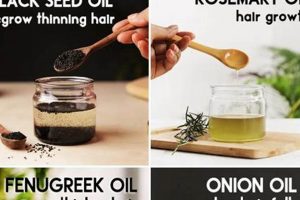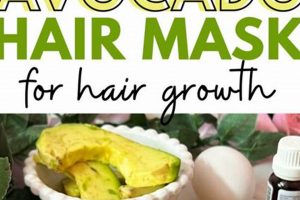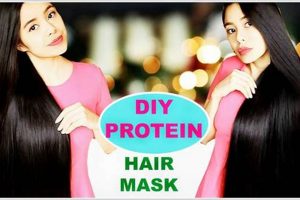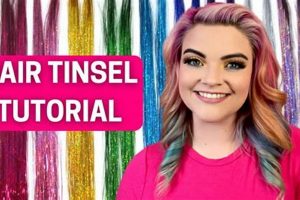A customized hair treatment crafted at home, specifically formulated for coiled and textured hair, constitutes a practical approach to hair care. This type of preparation frequently incorporates natural ingredients readily available in a domestic setting. An example would be a blend of avocado, honey, and olive oil, mashed and applied to the hair to impart moisture.
Such treatments provide several advantages, including cost-effectiveness, control over ingredients, and the ability to address specific hair concerns like dryness, frizz, and lack of definition. Historically, the practice of utilizing natural substances for hair and skin care predates commercially produced products, reflecting a reliance on accessible resources and traditional knowledge.
The subsequent sections will delve into various formulations suitable for different curl types, along with guidelines on application techniques and considerations for achieving optimal results through homemade hair remedies.
Essential Considerations for Homemade Coiled Hair Treatments
Achieving desired results from homemade treatments for textured hair necessitates careful attention to ingredient selection, application methods, and individual hair characteristics. The following points provide guidance for maximizing the efficacy of these preparations.
Tip 1: Ingredient Selection Based on Hair Type: Different curl patterns and porosity levels require specific ingredients. For example, individuals with low porosity hair may benefit from lighter oils such as grapeseed or almond oil, which are more readily absorbed. Conversely, high porosity hair may require richer ingredients like shea butter or coconut oil to seal in moisture.
Tip 2: Prioritize Fresh, Natural Ingredients: The efficacy of the treatment is often correlated with the quality and freshness of the components. Opt for organic and unprocessed items whenever feasible. Avoid ingredients with added chemicals or preservatives, as these may negate the intended benefits.
Tip 3: Perform a Patch Test: To mitigate the risk of allergic reactions or adverse effects, apply a small amount of the prepared treatment to a discreet area of skin, such as the inner arm, and observe for 24-48 hours before applying it to the entire head.
Tip 4: Consistent Application and Timing: Adherence to a consistent application schedule is crucial for observing tangible improvements. Typically, a treatment should be applied once or twice per week, leaving it on for 20-30 minutes to allow for adequate absorption and penetration.
Tip 5: Proper Application Technique: Ensure even distribution of the treatment throughout the hair, focusing on the ends, which are often the driest and most prone to damage. Employ a wide-tooth comb or fingertips to work the product through each strand systematically.
Tip 6: Thorough Rinsing: After the designated application time, rinse the hair thoroughly with lukewarm water to remove any residue. Incomplete rinsing can lead to product buildup and a dull appearance.
Tip 7: Monitor and Adjust as Needed: Regularly assess the hair’s response to the treatment and adjust the formulation or application frequency accordingly. The ideal regimen is tailored to the unique needs of the individual’s hair.
Effective execution of these homemade treatments necessitates careful planning, precise execution, and ongoing evaluation to optimize the health and appearance of textured hair.
The subsequent section will explore specific recipes tailored to address a range of common concerns pertaining to coiled hair.
1. Hydration restoration
The process of replenishing moisture to coiled and textured hair, known as hydration restoration, is intrinsically linked to the practice of creating customized, homemade treatments. Coiled hair, due to its structure, is inherently more susceptible to moisture loss than straight hair. The tight curls impede the natural distribution of sebum, the scalp’s natural oil, along the hair shaft. This inherent dryness necessitates deliberate interventions to maintain optimal moisture levels.
Homemade treatments offer a direct means of achieving hydration restoration through the inclusion of humectants, emollients, and occlusives. Humectants, such as honey or agave nectar, attract moisture from the air and draw it into the hair shaft. Emollients, including oils like avocado or shea butter, soften the hair and improve its flexibility. Occlusives, such as beeswax or coconut oil, form a protective barrier that prevents moisture from escaping. A treatment that combines these elements can effectively combat dryness and enhance the hair’s overall health. For example, a treatment comprising mashed banana (emollient), honey (humectant), and coconut oil (occlusive) can deeply hydrate and condition dry, brittle curls. The DIY aspect empowers individuals to tailor the formulation precisely to their hair’s specific needs and environmental conditions.
Therefore, the connection between hydration restoration and personalized hair treatments lies in the ability to directly address the moisture deficit common in coiled hair. The significance resides in proactively managing dryness to prevent breakage, improve elasticity, and enhance curl definition. While commercially available products exist, the customizable nature of DIY treatments provides a targeted approach to moisture replenishment, making it a valuable strategy for maintaining healthy, vibrant textured hair. The continuous adjustment of the masks components is the best way to achieve the best result for this hair, depending the case.
2. Curl definition enhancement
The enhancement of curl definition represents a primary objective for individuals with textured hair, and this goal is frequently addressed through the application of customized, homemade hair treatments. The inherent structure of coiled hair often leads to a lack of uniform curl formation, resulting in frizz, undefined patterns, and a perceived lack of manageability. Consequently, treatments designed to accentuate and maintain curl definition are highly valued.
The application of specific ingredients can directly impact curl definition. For example, flaxseed gel, prepared by boiling flaxseeds in water, provides a natural hold and enhances curl clump formation. Ingredients with humectant properties, such as aloe vera gel, draw moisture into the hair shaft, promoting elasticity and reducing frizz, thereby contributing to defined curls. Additionally, the proper application technique, such as the “scrunching” method, in conjunction with a treatment containing these ingredients, further accentuates the natural curl pattern. For example, a treatment comprising aloe vera gel, a small amount of shea butter for moisture retention, and flaxseed gel for hold, applied using the scrunching method, can significantly improve curl definition, reducing frizz and enhancing the overall appearance of textured hair. Different ingredients would work according hairtype to improve curl defintion.
In summary, the pursuit of enhanced curl definition frequently motivates the use of customized hair treatments. The understanding of ingredient properties and application techniques allows for the creation of formulations that directly address the challenges associated with achieving well-defined, manageable curls. While genetics play a role in determining inherent curl pattern, targeted treatments provide a means of optimizing and enhancing the hair’s natural texture. The success of enhancing curl definition is greatly influenced by the correct diagnosis of needs and applying this data to the mix for diy curly hair mask.
3. Damage repair
Damage to coiled and textured hair, characterized by breakage, split ends, and loss of elasticity, frequently stems from chemical treatments, heat styling, and environmental factors. The application of customized, homemade treatments offers a potential avenue for mitigating this damage. These treatments, formulated with specific ingredients, aim to restore structural integrity and improve overall hair health. A typical example involves incorporating protein-rich components, such as hydrolyzed proteins or yogurt, which fill in gaps in the hair cuticle, thereby strengthening the hair shaft. Oils, like olive or coconut, penetrate the hair shaft, providing lubrication and reducing friction, which minimizes breakage. The selection of ingredients directly addresses the underlying causes of damage and promotes repair.
The effectiveness of such treatments hinges on understanding the specific type of damage present. Protein treatments, for example, are most beneficial for hair lacking structural integrity, whereas moisture-rich treatments are more suitable for dry, brittle hair. Overuse of protein treatments can, paradoxically, lead to further breakage, highlighting the importance of balance. An example of a practical application involves a treatment composed of avocado (rich in fatty acids), honey (a humectant), and a small amount of hydrolyzed keratin. This combination provides both moisture and protein, addressing multiple aspects of damage. Consistent application, coupled with minimizing damaging practices like heat styling, can contribute to visible improvements in hair health.
In summary, damage repair constitutes a significant consideration in the application of homemade hair treatments for coiled hair. The understanding of ingredient properties and their effects on hair structure is paramount. The customization aspect allows for targeted interventions, addressing specific types of damage. The challenge lies in accurately diagnosing the hair’s needs and formulating treatments that provide the correct balance of moisture and protein. Effective damage repair, achieved through informed application of homemade treatments, promotes stronger, healthier, and more resilient textured hair.
4. Ingredient compatibility
The efficacy of a homemade coiled hair treatment is fundamentally linked to the compatibility of its constituent ingredients. Adverse reactions or diminished performance often arise from combining incompatible substances. The interaction between components can either amplify desired effects or negate them entirely, affecting the overall outcome of the treatment. For instance, mixing oil-based ingredients with water-based ingredients without an emulsifier can lead to separation and uneven distribution, reducing the treatment’s effectiveness. Furthermore, some oils, when combined, may create a greasy residue, weighing down curls and diminishing volume. Proper understanding of ingredient properties and potential interactions is therefore essential for successful formulation.
Practical examples illustrate the importance of compatibility. The combination of acidic ingredients, such as apple cider vinegar, with protein-rich ingredients, like egg yolk, can cause protein coagulation, potentially leading to a stiff or brittle texture rather than the intended strengthening effect. Conversely, combining humectants, like honey or glycerin, with emollients, such as shea butter or coconut oil, creates a synergistic effect, drawing moisture into the hair shaft and sealing it in, maximizing hydration. Understanding the pH levels and molecular structures of ingredients allows for the creation of balanced formulations that deliver targeted benefits without causing adverse reactions. The application of essential oils also presents a compatibility issue. Certain essential oils, such as tea tree oil, can be irritating if not properly diluted with a carrier oil, such as jojoba or almond oil, causing scalp sensitivity or allergic reactions.
In conclusion, ingredient compatibility represents a critical consideration in homemade hair treatments for textured hair. The careful selection and combination of compatible ingredients ensure that the treatment delivers the intended benefits hydration, curl definition, or damage repair without causing adverse effects. The challenge lies in acquiring sufficient knowledge of ingredient properties and potential interactions. The practical significance of this understanding is directly reflected in the improved health, appearance, and manageability of coiled hair, achieved through well-formulated and compatible homemade treatments. The lack of such understanding might even create a worse scenario for the hair.
5. Application frequency
The application frequency of homemade hair treatments for coiled hair exerts a direct influence on the treatments’ effectiveness and the overall health of the hair. Establishing an appropriate schedule for applying these preparations is crucial to avoid both under-treatment, which fails to deliver sufficient benefits, and over-treatment, which can lead to adverse effects. The cause-and-effect relationship is evident: infrequent application may not provide adequate hydration or nutrient delivery, while excessive application can result in product buildup, scalp irritation, and altered hair texture. Understanding this connection is a fundamental component of successfully utilizing these hair treatments. For example, applying a protein treatment weekly to already protein-rich hair could lead to brittleness and breakage, while applying a moisturizing treatment bi-weekly to extremely dry hair may not provide sufficient hydration.
The ideal application frequency varies based on several factors, including hair porosity, the specific ingredients in the treatment, and environmental conditions. High-porosity hair, which readily absorbs and loses moisture, may benefit from more frequent treatments compared to low-porosity hair. Similarly, treatments containing potent ingredients, such as essential oils or strong proteins, may require less frequent application to avoid irritation or protein overload. Seasonal changes also play a role; drier climates typically necessitate more frequent moisturizing treatments. A practical approach involves observing the hair’s response to the treatment and adjusting the frequency accordingly. If hair appears dry and brittle, increasing the frequency of moisturizing treatments may be warranted. Conversely, if hair feels heavy or greasy, reducing the frequency is advisable. Trial and error, guided by careful observation, is essential for establishing the optimal application schedule.
In conclusion, the application frequency of homemade hair treatments for coiled hair is a critical determinant of their efficacy. Finding the right balance requires considering various factors and continuously monitoring the hair’s response. The challenge lies in adapting the application schedule to meet the unique needs of individual hair, taking into account its porosity, the specific treatment’s ingredients, and environmental conditions. Understanding and addressing this factor contributes significantly to achieving and maintaining healthy, well-nourished textured hair.
6. Scalp health
The condition of the scalp directly influences the health and vitality of coiled hair. Homemade hair treatments, therefore, must consider scalp health to promote optimal hair growth and minimize potential issues.
- Ingredient Selection and Scalp Sensitivity
Certain components in homemade preparations can irritate sensitive scalps. For instance, concentrated essential oils, such as tea tree or peppermint, while potentially beneficial, can cause redness, itching, or inflammation if not properly diluted or if an individual has an underlying sensitivity. Conversely, soothing ingredients like aloe vera or chamomile may alleviate scalp irritation. The selection of ingredients must prioritize scalp health to avoid adverse reactions and maintain a balanced scalp environment.
- Scalp Cleansing and Product Buildup
Product buildup, often resulting from frequent use of heavy oils or butters in homemade treatments, can clog hair follicles and impede healthy hair growth. Regular scalp cleansing is essential to remove this buildup and maintain a clean scalp environment. Ingredients such as apple cider vinegar, when used sparingly and properly diluted, can act as a natural cleanser, removing residue without stripping the scalp of its natural oils. Neglecting scalp cleansing can lead to inflammation, dandruff, and potentially even hair loss.
- Nutrient Delivery and Scalp Absorption
The scalp’s ability to absorb nutrients from homemade treatments can contribute to improved hair health. Ingredients like avocado oil, rich in vitamins and fatty acids, can nourish the scalp, promoting stronger and healthier hair growth. Gentle scalp massage during application can further enhance nutrient absorption by increasing blood flow to the hair follicles. However, the effectiveness of nutrient delivery is contingent upon the overall health of the scalp, with a healthy scalp being more receptive to nutrient absorption than one that is inflamed or congested.
- pH Balance and Scalp Health
Maintaining the scalp’s natural pH balance is crucial for preventing fungal or bacterial overgrowth, which can lead to dandruff, itching, and other scalp conditions. Ingredients with acidic properties, like lemon juice, can help restore pH balance. However, excessive use of acidic ingredients can disrupt the scalp’s natural protective barrier. Therefore, the formulation of homemade treatments must consider pH balance to support a healthy scalp environment and prevent potential imbalances.
In summary, scalp health represents an integral aspect of utilizing homemade hair treatments for coiled hair. Selecting appropriate ingredients, ensuring regular cleansing, promoting nutrient delivery, and maintaining pH balance all contribute to a healthy scalp environment, which, in turn, fosters optimal hair growth and minimizes potential scalp issues. The neglect of scalp health can undermine the benefits of even the most carefully formulated treatment.
Frequently Asked Questions
The following addresses common queries regarding the creation and application of homemade hair treatments specifically formulated for coiled and textured hair.
Question 1: Can a homemade hair treatment effectively address severe hair damage comparable to professional salon treatments?
Homemade preparations, while beneficial, might not replicate the intensive repair capabilities of professional salon treatments, particularly in cases of extreme damage. Salon treatments often employ specialized equipment and concentrated formulations unavailable for domestic use. However, consistent application of well-formulated treatments can significantly improve hair health over time.
Question 2: Is it necessary to use organic ingredients exclusively in a homemade hair treatment?
The utilization of organic ingredients is preferable but not mandatory. Organic ingredients minimize exposure to synthetic pesticides and chemicals. However, the priority remains selecting high-quality, fresh ingredients, regardless of organic certification.
Question 3: How can allergic reactions to a homemade hair treatment be prevented?
A patch test, performed by applying a small amount of the prepared treatment to a discreet area of skin 24-48 hours prior to full application, is crucial. If any adverse reaction occurs, such as redness, itching, or swelling, discontinue use immediately.
Question 4: Can homemade hair treatments cause product buildup on the scalp and hair?
Overuse of heavy oils and butters in homemade treatments can lead to product buildup. Regular scalp cleansing with clarifying shampoos or diluted apple cider vinegar can mitigate this issue.
Question 5: How long should a homemade hair treatment be left on the hair for optimal results?
Typically, a treatment should be applied for 20-30 minutes. However, the optimal duration can vary depending on the specific ingredients and hair porosity. Observing the hair’s response and adjusting the timing accordingly is recommended.
Question 6: Can homemade hair treatments alter the natural curl pattern of coiled hair?
Homemade treatments are designed to enhance, not alter, the natural curl pattern. Ingredients can improve curl definition, reduce frizz, and increase manageability but will not fundamentally change the inherent curl type.
The key takeaway is informed and responsible use of these treatments, understanding ingredient properties and potential effects.
The following section will explore specific recipes suitable for various curl types.
Conclusion
The preceding discussion has illuminated various facets of the practice of creating customized hair treatments for coiled and textured hair. Key considerations include ingredient selection based on hair type and porosity, proper application techniques, and the maintenance of scalp health. Success hinges upon a thorough understanding of ingredient properties and their potential interactions, as well as consistent monitoring of the hair’s response to the treatments.
The formulation and application of homemade coiled hair treatments represent an ongoing process of experimentation and refinement. Continued research and careful observation are essential for maximizing the benefits and minimizing potential adverse effects. The potential for enhanced hair health and manageability warrants diligent effort in this endeavor.







